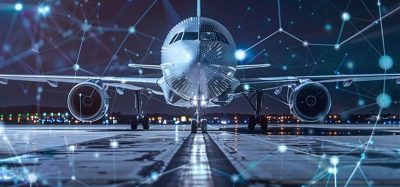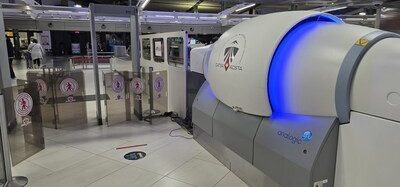An integrated approach to civil aviation security
Posted: 7 August 2014 | Ken Mann, Chairman, EOS Civil Aviation Security Working Group | No comments yet
Harmonising the standards for security equipment within the civil aviation industry is a vital step for the future of airport security. Ken Mann, Chairman of the EOS Civil Aviation Security Working Group, reveals the challenges with implementation.
The European Organisation for Security (EOS) is a Brussels-based administration which represents many security companies with a strong European presence. This ranges from very large multi-national companies with multiple and diverse interests in the security sphere, all the way down to micro-SMEs and start-ups. EOS covers many aspects of the security industry with dedicated working groups, made up from its members, in areas such as cybersecurity, border security, maritime surveillance, urban security, civil protection, supply chain security as well as civil aviation security. EOS working groups will focus on issues of the day in those fields and will liaise and interact with various European institutions and bodies as appropriate to provide expertise and strengthen collaboration between all security stakeholders.
As a result of many years of terrorist plots and attacks – some failed and some successful – the global aviation industry has been forced to introduce many more rigorous security measures than in other sectors. The aviation sector represents a target for terrorists which can cause mass casualties and destruction and provide enormous publicity for their cause. As an example, even failed attacks such as the printer bomb plot instigated by Al Qaeda in the Arabian Peninsula (AQAP) was purported by AQAP to be a success having a claimed cost of just $4000, but the costs to the aviation industry in response have been many millions of dollars. Whilst this is clearly propaganda to make the best of what was, in essence, a failure, there is some truth that the costs to respond have been high. Due to the fact that aviation attacks are extremely high profile and have the promise of terrible mass casualties and enormous economic impact, terrorists have returned again and again to target this sector despite the great effort and expense that is invested in protecting global travel by the aviation industry and the authorities to keep commercial flights safe.
Whereas many of EOS’ working groups operate in an environment where there is no or limited regulation and threats are often ill-defined, by contrast the EOS Civil Aviation Security Working Group (EOS CASWG) operates in the heavily regulated and mature area of aviation security. Furthermore, the aviation industry has an extremely complex stakeholder map with many affected parties and organisations. Airlines obviously have a great deal of responsibility for security, though very often it is the airports that are responsible for the visible security we see in terms of central search and hold baggage screening. There are exceptions and in certain countries it is governments that are responsible for providing security, but more often than not the airports have that task, sometimes using direct staffing and sometimes using security contractors.
Free webinar – The future of asset management in global aviation
15 January, 2026, 02:00PM GMT
Join this virtual panel to hear from some of the AtkinsRéalis and aviation sector experts as we discuss how asset management is changing and the impact it will have on the future operations of airports throughout the world.
International baseline security standards are dictated by ICAO. However, in the European Economic Area, regulations are driven by the European Commission, though the story does not end there as European Member States Governments are both responsible for enforcing regulation in their own countries but also, frequently, apply more stringent measures and specific local security requirements. Added to this is the fact that particular countries, among them the United States, often insist that additionally their own security requirements are enforced for flights to those countries, resulting in a rather complex and detailed regulatory picture. As such, EOS provides the voice of the security technology industry in the development of policy and regulation and keeps its members updated on policy changes and initiatives. EOS CASWG works closely with the European Commission, Member States, Transportation Security Administration, European Civil Aviation Conference and other industry stakeholders such as associations representing airports (ACI-E), airlines (IATA, AEA, ERA) and the retail trade industry (ETRC). Our members include, among others, Cobalt Light Systems, Gilardoni, Kromek, L3 Communication, Morpho Detection, Multix, OptoSecurity, Rapiscan Systems, Sedener, Siemens and Smiths Detection: these are all security and detection technology industrial developers with a strong European presence.
Work is often collaborative and EOS is engaged with other stakeholders in a variety of forums including, importantly, operational working groups focussed on ensuring successful roll-outs of new technologies and processes with multiple stakeholders represented from across the industry.
Since the 1960s and 1970s security technology has improved significantly. From the introduction of basic metal detectors and fluoroscopic x-ray imaging systems there have been many advances. For example, x-ray machines have evolved to have dual energy imaging and facilities such as Threat Image Projection, to test operator performance. They have now progressed to have ever-more accurate automated threat detection capabilities to assist operators in their decisions and reduce their mental load and, in addition, enable capabilities such as the screening of liquids. Advances in other areas include the development of body scanners that detect all types of threats on the person, including explosives and non-metallic weapons automatically and immediately without the need for operators to look at revealing images. A further example is the development of Standard 3 EDS hold baggage screening systems that screen at very high speed with very low false alarm rates, reducing the number of operators needed to review false alarms and removing the need for multiple screening levels and multiple screening machines. In addition to the scanning and screening security measures of course, electronic security technologies such as video surveillance and associated intelligent analytics together with access control platforms featuring intelligent biometric identification traits, are deployed throughout airports to ensure the highest possible levels of security to staff and passengers alike.
European security technology developers are very focused on improving all aspects for the passenger. Clearly improved security has to be the primary focus but it is important to understand that the possibilities of adopting improved security technology and procedures are greatly enhanced by making improvements in facilitation. Particularly hot topics at present are the screening of liquids, aerosols and gels, the adoption of Standard 3 hold baggage screening systems and the increased use of explosive trace detection and body scanners. It is often necessary for regulators to impose enhanced security measures in response to events and threat intelligence, but this is somewhat balanced with the need to keep the airport operations running smoothly and efficiently – if technology is well thought out it can provide improved throughput and facilitation at the same time as adding greatly improved security. Airports obviously have to provide high levels of security, where possible, and we would like to enable them to do this with process efficiencies that help justify investment in new technology and do not bring airports to a standstill.
Advanced cabin baggage screening (ACBS) is also a key topic at present. ACBS covers a range of screening technologies for the screening of cabin baggage that has the promise of delivering benefits to all stakeholders due to the possibilities for increased throughput, increased security, the ability to screen liquids and the ability to utilise resources such as screening staff more efficiently. Several technologies already exist which can be considered ACBS that could allow both liquid screening in divested and non-divested modes (type C or D) and the reintroduction of laptops into bags. The technologies include dual and multi-view imaging, dual or multi-energy x-ray systems, computed tomography x-ray systems as well as x-ray diffraction. All have pros and cons in terms of cost, size, throughput and detection/false alarm trade-offs, but all have significant potential. EOS is committed to working with airports, regulators and other stakeholders to increase the adoption of this type of technology. Standards are currently being discussed and EOS is hopeful that standards are set and approval tests formulated promptly to allow the timely adoption of ACBS. ACBS is one example where standards do exist in the United States that could be adopted or adapted for use in Europe. An aim of EOS is to encourage the adoption of harmonised standards for all manner of security equipment. The U.S. and EU often have very similar but slightly varying requirements. There is the potential for cost-saving and rapid introduction of technologies if standards and test methods can be harmonised, enabling the EU regulators to rapidly organise test and certifications campaigns.
EOS – as a representative body of EU-based manufacturers – wishes to maintain an EU independent and univocally recognised method of testing and certifying equipment, independent from any other National entity (U.S., China, etc.) and yet harmonised.
The advent of risk-based security would potentially be both a threat and an opportunity for detection equipment developers. If risk-based security meant that a large proportion of the population was not screened then obviously less equipment would be needed. However, it is not likely that would be the case and there will, most probably, be a minimum requirement for screening of all passengers. However, with more advanced automated screening technologies, the possibilities open up for several options where passengers receive different levels of scrutiny based on perceived risk. For example, body scanners or ACBS systems may apply a more rigorous threat detection algorithm with close to 100 per cent detection but higher false alarm rates for someone defined as high risk, or scans that take longer to perform may be applied, whereas a different algorithm may be applied for a trusted passenger with a lower false alarm rate.
Alternatively divestment requirements may vary from passenger to passenger based on their risk profile. There are many possibilities when more capable equipment is deployed. EOS members are eager to support IATA and ACI’s joint Smart Security programme with technical screening solutions. One of the main problems with risk-based security is understanding how passenger differentiation can be achieved in Europe to select passengers as, for instance, high, medium and low risk. Given much of Europe’s experience in the 20th century, privacy and discrimination issues are a very sensitive subject and may pose significant obstacles to having continent wide databases and information sharing.
It is impossible to predict the future with great accuracy but we anticipate more advanced equipment with better detection capabilities being deployed. However, this is only likely where the equipment deployed offers advantages to the airports and justifies investment. If a new technology detected all known threats but was not operationally viable it would not be deployed. Even when deemed necessary by regulators there have been instances where the airports have objected to being forced to deploy technologies they deem not operationally deployable and there have been delays in deployment until operational issues can be resolved. We are keen, as an industry, to work with our customers as well as with regulators to continually improve security but also to help make the screening process less onerous and costly for the airports and, more critically, the ultimate customer, the travelling public.
For further information visit www.eos-eu.com
Biography
Ken Mann is Chairman of EOS Civil Aviation Security Working Group and Cobalt Light Systems’ Vice President. He has over 20 years’ experience in aviation security, currently VP Security Products at Cobalt Light and Chair of the EOS Civil Aviation Security Working Group. Previously Ken worked at Rapiscan where he was responsible for the development of the RTT and other detection technologies. Before that, he developed security equipment at Quantum Magnetics and DSTL.
Stay Connected with International Airport Review — Subscribe for Free!
Get exclusive access to the latest airport and aviation industry insights from International Airport Review — tailored to your interests.
✅ Expert-Led Webinars – Gain insights from global aviation leaders
✅ Weekly News & Reports – Airport innovation, thought leadership, and industry trends
✅ Exclusive Industry Insights – Discover cutting-edge technologies shaping the future of air travel
✅ International Airport Summit – Join our flagship event to network with industry leaders and explore the latest advancements
Choose the updates that matter most to you.
Sign up now to stay informed, inspired, and connected — all for free!
Thank you for being part of our aviation community. Let’s keep shaping the future of airports together!


















